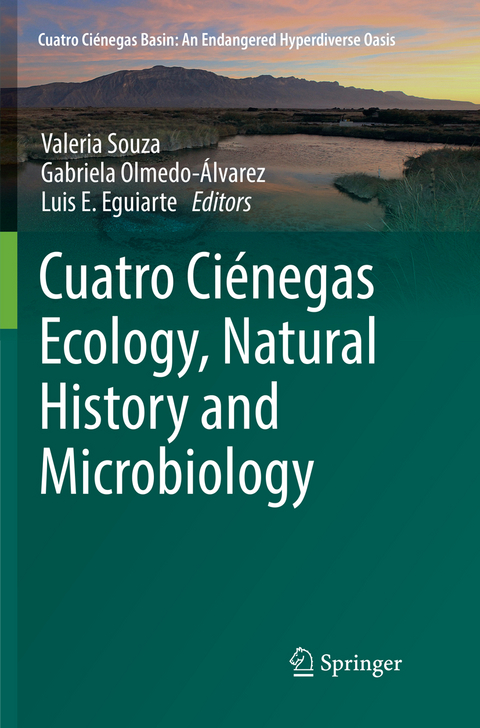
Cuatro Ciénegas Ecology, Natural History and Microbiology
Springer International Publishing (Verlag)
978-3-030-06657-4 (ISBN)
Valeria Souza was born in Mexico City and completed her bachelor's degree in Biology, master's degree in Genetics and PhD in Ecology at the National Autonomous University of Mexico (UNAM). In 1990 Valeria went to Irvine California (UCI) to work with Rich Lenski and learn experimental evolution. In 1993, she took on a research position at UNAM in Mexico, where she still works today. Her field is Evolutionary Ecology of Microbes and when Valeria completed her PhD, there were no other researchers studying it in Mexico, and very few in the world. As a young researcher, she received a MacArthur fellowship to investigate the role of women in biodiversity and she chose to explore how domestications had changed microbial populations and published a paper on ethnomicrobiology. At the same time she began exploring the role of bacterial sex in the evolution of the pathogenicity in E. coli comparing human related strains with wild animal isolates. In 1999, all of those more predictable trails in academia changed when Valeria and her family were invited by NASA to explore a new world in a journey that led them to the depths of microbial biodiversity in an unlikely oasis in the Chihuahuan desert. Dr. Gabriela Olmedo studied Biology at Universidad Autonoma de Mexico, and she obtained her Ph.D. at the University of Pennsylvania, U.S.A in 1990. In May 1990 she started working as an independent researcher at Cinvestav Unidad Irapuato. Using biochemical and genetic strategies her group has described some mechanisms involved in the decay of mRNAs as well as those required for maturation of tRNA, mainly in the bacterial model Bacillus subtilis. Her group is also interested in understanding community interactions and ecological adaptations of bacteria, particularly of the Bacillus genus. Some of the main models for study are the microbial communities in aquatic systems of Cuatro cienegas, Coahuila, Mexico. With her collaborators, she has also employed microbial, genomic, and metagenomic approaches to reveal the species and gene pools that dominate different sediment and water systems. Her group has also maintained the Ciencia Viva scientific workshop for undergraduate students for fifteen years. She was chair of the Department of Genetic Engineering at Centro de Investigacion y Estudios Avanzados del I.P.N., Unidad Irapuato from 2007 to 2013, and has since been the director there.
Chapter 1 - Why Cuatro Ciénegas Basin (CCB) is so special, a walk through the ages: Valeria Souza (UNAM, MX).- Chapter 2 - The Global Climate Change footprint at Cuatro Ciénegas, Mexico: the increment of Extreme Climatic Event frequencies and its relation with water management: Cristina Montiel-González, Francisco Bautista, Oscar Sánchez-Meneses and Felipe García-Oliva (UNAM, MX).- Chapter 3 - Microbial saga: from the ancient past to the present: Valeria Souza, Luis Eguiarte (UNAM, MX), Gabriela Olmedo (CINVESTAV, MX), Michael Travisano (University of Minnesota, USA) and Janet Siefert (Rice University, USA).- Chapter 4 - Hyper-diversity of Virus in CCB: Blanca Taboada, Pavel Isa, Ana Lorena Gutiérrez, Rosa Maria del Ángel (UNAM, MX), Juan Ludert (CINVESTAV, MX), Ana Cecilia Espinosa, Luis E Eguiarte., Susana López, Valeria Souza and Carlos Arias ;(UNAM, MX).- Chapter 5 - How divergent is this oasis? Microbial population genomics studies: Mirna Vazquez; Zulema Gómez; Gabriel Yaxal (UNAM, MX), Gabriela Olmedo (CINVESTAV, MX), Valeria Souza Alejandra Moreno and Luis Eguiarte (UNAM, MX).- Chapter 6 - Microbial ecology in CCB: The survival at the edge of life, mutualisms with locals and antagonisms with the foreigners: Experimental and metagenomics evidence: Laura Espinosa, Eneas Aguirre, Patricia Vélez, Gabriela Olmedo (CINVESTAV, MX), Valerie de Anda, Luis E. Eguiarte and Valeria Souza (UNAM, MX).- Chapter 7 - Mesocosms and other experiments: a way to test resilience of a community: Esmeralda Nguyen López (IPICYT, MX) , Silvia Pajares (UNAM, MX) , Gabriela Olmedo (CINVESTAV, MX), Ana Escalante, Luis Eguiarte and Valeria Souza (UNAM, MX).- Chapter 8 - Bacillus as system model: Diversity and distribution, the bacillus tale: Gabriela Olmedo (CINVESTAV, MX), Ma. Dolores Rodriguez, Luis David Alcaraz, Valeria Souza (UNAM, MX).- Chapter 9 - Ecological adaptability of Bacillus to the extreme oligotrophy of the Cuatro Cienegas Basin: Jorge Valdivia-Anistro, Luis Eguiarte-Fruns and Valeria Souza (UNAM, MX).- Chapter 10 - Actinobacteria, the story of the biotechnology potential: Héctor Arocha, Susana de la Torre, Hamlet Aviles, Francisco Barona (CINVESTAV, MX).- Index.
| Erscheinungsdatum | 14.01.2019 |
|---|---|
| Reihe/Serie | Cuatro Ciénegas Basin: An Endangered Hyperdiverse Oasis |
| Zusatzinfo | XIV, 134 p. 26 illus., 23 illus. in color. |
| Verlagsort | Cham |
| Sprache | englisch |
| Maße | 155 x 235 mm |
| Gewicht | 238 g |
| Themenwelt | Naturwissenschaften ► Biologie ► Mikrobiologie / Immunologie |
| Naturwissenschaften ► Biologie ► Ökologie / Naturschutz | |
| Schlagworte | Astrobiology • climate change • conservation policy • Desert oasis • Microbial diversity • Stromatolites and Microbial Mats |
| ISBN-10 | 3-030-06657-6 / 3030066576 |
| ISBN-13 | 978-3-030-06657-4 / 9783030066574 |
| Zustand | Neuware |
| Haben Sie eine Frage zum Produkt? |
aus dem Bereich


